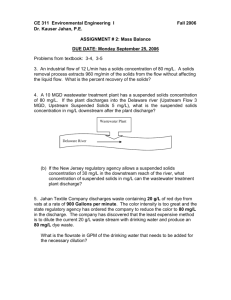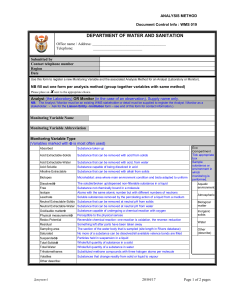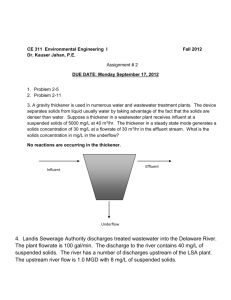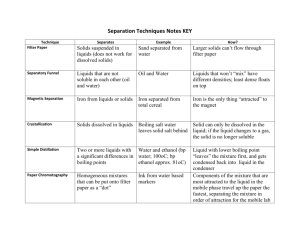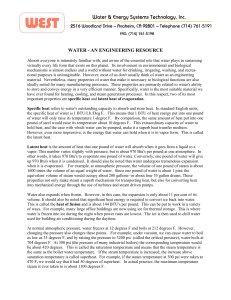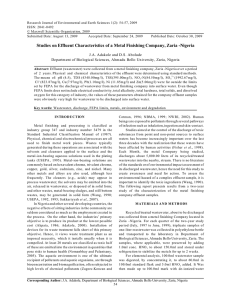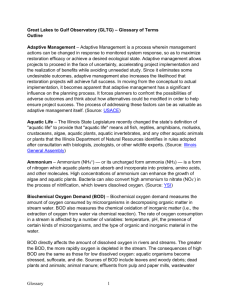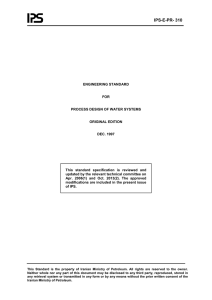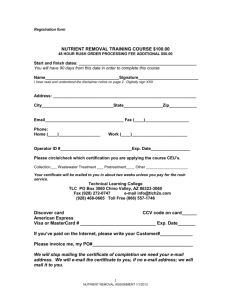Laboratory Exam
advertisement
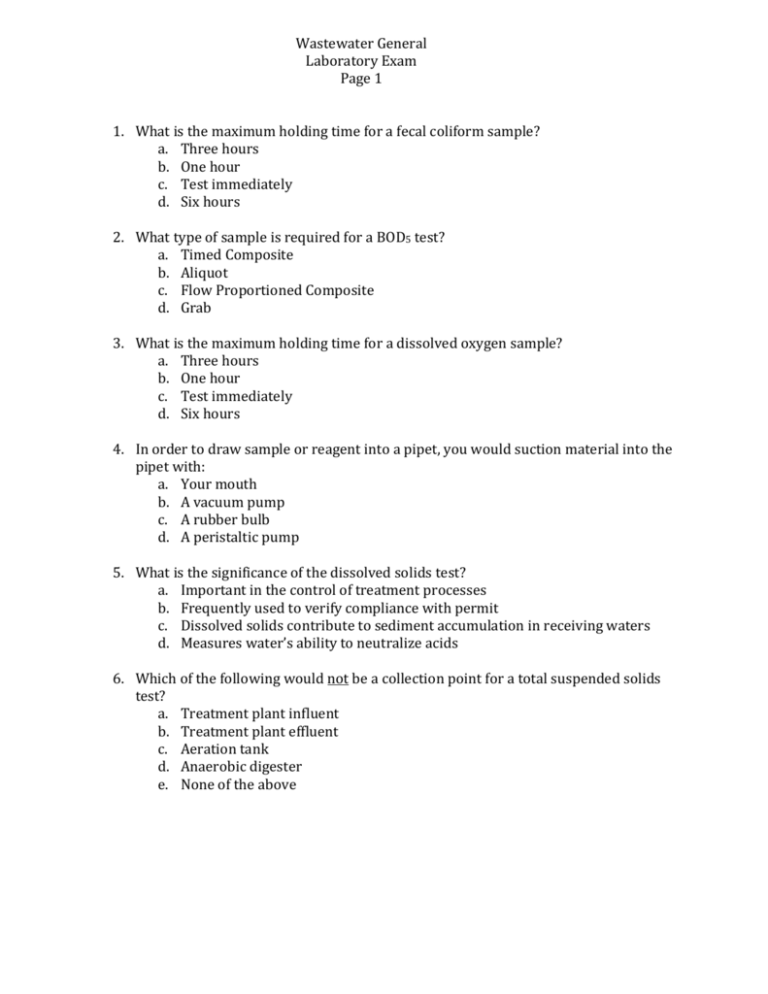
Wastewater General Laboratory Exam Page 1 1. What is the maximum holding time for a fecal coliform sample? a. Three hours b. One hour c. Test immediately d. Six hours 2. What type of sample is required for a BOD5 test? a. Timed Composite b. Aliquot c. Flow Proportioned Composite d. Grab 3. What is the maximum holding time for a dissolved oxygen sample? a. Three hours b. One hour c. Test immediately d. Six hours 4. In order to draw sample or reagent into a pipet, you would suction material into the pipet with: a. Your mouth b. A vacuum pump c. A rubber bulb d. A peristaltic pump 5. What is the significance of the dissolved solids test? a. Important in the control of treatment processes b. Frequently used to verify compliance with permit c. Dissolved solids contribute to sediment accumulation in receiving waters d. Measures water’s ability to neutralize acids 6. Which of the following would not be a collection point for a total suspended solids test? a. Treatment plant influent b. Treatment plant effluent c. Aeration tank d. Anaerobic digester e. None of the above Wastewater General Laboratory Exam Page 2 7. The Total Solids test result includes a. Parasites b. Dissolved solids c. Dissolved oxygen d. Oxidation-reduction potential 8. The alkalinity test measures a. The hydrogen ion concentration b. The ability to neutralize alkalinity c. The pH d. The ability to neutralize acids 9. The BOD5 test is used to estimate a. The amount of oxygen needed for bacteria to consume wastes b. The volatile solids concentration c. How long it will take for bacteria to consume all of the wastes in a sample d. The amount of oxygen released into the water by dissolved wastes 10. The presence of fecal coliform in a sample indicates the presence of a. Human waste b. Amoebas c. Waste from warm blooded animals d. Specific pathogens 11. The test for residual chlorine is performed on treated effluent because: a. Some residual chlorine is needed to keep the effluent fresh b. Chlorine is toxic to aquatic life c. Chlorine reduces odors d. It helps avoid wasting chlorine through overdosing. 12. Where is the sample for residual chlorine collected? a. At the outfall b. In the treatment plant influent c. At the final clarifier d. At the point of application 13. The Nitrate/Nitrite analysis is important because: a. It causes algae blooms, and puts an excessive amount of oxygen in the water b. It combines with potassium to create an explosive substance c. It is reduced by bacteria to elemental nitrogen, causing air pollution d. It causes algae blooms, which decompose and consume oxygen in the water 14. What is the significance of ammonia in wastewater treatment? a. It is used as a source of alkalinity to raise the pH of the wastewater b. It exerts an oxygen demand on the receiving waters Wastewater General Laboratory Exam Page 3 c. In the anoxic treatment zone, it oxidizes BOD d. It causes disease in humans 15. In a laboratory analysis, what is a blank and why is it used? a. A form used to record laboratory results b. A sample containing only dilution water, used to see if the dilution water affects the results of the test c. Uncalibrated glassware used as a reaction vessel for sample digestion d. A micropore filter with no grid, used to culture bacteria for subsequent staining and microscopic analysis 16. When working with contaminated samples, what is the best defense against diseases contracted through inhalation and ingestion? a. Latex gloves b. Fume hood c. Eyewash and shower d. Immunizations 17. What is a grab sample? a. A sample containing a single dipper of water b. A sample collected over 24 hours at specific time intervals c. A sample collected over 24 hours at specific flow totals d. A sample collected over 24 hours in separate containers, then mixed together 18. How is a phosphorus sample preserved? a. Add sodium hydroxide to pH>11, and refrigerate at 4 deg. C up to 28 days b. Neutralize to pH=7, and refrigerate at 4 deg. C up to 28 days c. Add sulfuric acid to pH<2, and refrigerate at 4 deg. C up to 28 days d. Refrigerate at 4 deg. C up to 48 hours 19. Total Kjeldahl Nitrogen includes: a. Nitrate, nitrite and amino acids b. Organic nitrogen and ammonia c. Dimeric nitrogen d. Nitrate, nitrite and ammonia 20. What is a buret used for? a. Titration b. Filtration c. Bacteria culture d. Keep samples dry while they cool
